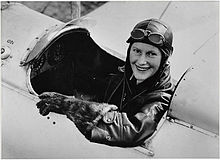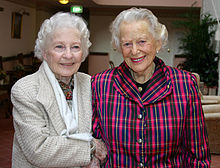- Nancy Bird Walton
-
Nancy Bird-Walton 
Nancy Bird Walton in a Gypsy Moth at Kingsford-Smith Flying School (1933)Born 16 October 1915
Kew, Australia [1]Died 13 January 2009 (aged 93) Nationality Australian Aviation career Known for youngest Australian woman to gain a pilot's licence First flight 1933 Flight license 27 September 1933[1] Awards Order of Australia (1966), Order of British Empire, Venerable Order of Saint John  Nancy Bird-Walton (right) with another pioneering Australian aviatrix, Jean Burns (2006).
Nancy Bird-Walton (right) with another pioneering Australian aviatrix, Jean Burns (2006).
Nancy Bird-Walton, AO, OBE, DStJ (16 October 1915 – 13 January 2009) was a pioneering Australian aviatrix, and was the founder and patron of the Australian Women Pilots' Association.
In the 1930s, defying the traditional role of females of her time, she became a fully qualified pilot at the age of 19, and became the youngest Australian woman to gain a pilot's licence.
Biography
Born in Kew, New South Wales, Australia on 16 October 1915 as Nancy Bird,[1] she wanted to fly almost as soon as she could walk. As a teenager during the Depression in Australia, Nancy Bird found herself in the same position as many other children of the time, leaving school at 13 to assist her family.[1] In 1933, at the age of 18, her passion drove her to take flying lessons. Sir Charles Kingsford Smith, who was the first man to fly across the mid-Pacific, had just opened a pilots' school near Sydney, and she was among his first pupils. Most women learnt to fly for recreation, but Nancy planned to fly for a living.
When she was awarded a commercial pilot's licence at the age of 18, through a legacy of 200 pounds from a great aunt plus money loaned from her father, (which she paid back), Nancy bought her first aircraft, a de Havilland Gipsy Moth. Soon after Nancy Bird and her friend Peggy McKillop took off on a barnstorming tour, dropping in on country fairs and giving joyrides to people who had never seen an aircraft before, let alone a female pilot. Whilst touring, Bird met Reverend Stanley Drummond. He wanted her to help set up a flying medical service in outback New South Wales. In 1935, she was hired to operate the service, named the Far West Children's Health Scheme. Bird's own Gipsy Moth was used as an air ambulance. She bought a better-equipped aircraft, and began covering territory not yet reached by the Royal Flying Doctor Service. She told others that it was rewarding but lonely work.
In 1936, Nancy Bird entered an air race from Adelaide to Brisbane, and won the Ladies' Trophy. In 1938 she decided to have a long break from flying. A Dutch airline company (KLM) invited her to do some promotional work in Europe, where she stayed for a couple of years. She returned to Australia soon after World War II broke out. She began training women in skills needed to back up the men flying in the Royal Australian Air Force. She was 24 when she married an Englishman, Charles Walton, and had two children. He preferred to call her "Nancy-Bird" rather than "Nancy", and she became generally known as "Nancy-Bird-Walton". In 1950, she founded the Australian Women Pilots' Association (AWPA),[1] where she remained president for five years. Nancy Bird-Walton became Patron of the AWPA in 1983 following the death of Lady Casey, the original Patron. In 1958, she decided to return to flying after a twenty year absence.
Throughout her life Walton was notable for her support of charities and people in need. This generous spirit saw her invested as an Officer of Order of the British Empire (OBE) in 1966. She was later appointed an Officer of the Order of Australia. She was the starting block for generations of female pilots. She was never involved in an accident, despite the risks of early aviation.
The National Trust of Australia declared her an Australian Living Treasure in 1997.
The first Airbus A380 (VH-OQA) delivered to Australian airline Qantas was named in her honour.[2] Her name on the A380 was originally written "Nancy Bird-Walton",[3] but Qantas respected her preference for the hyphenation that her late husband used ("Nancy-Bird"), and the hyphen was added before the aircraft's naming ceremony.
One of her last main interviews was for the feature length documentary film Flying Sheilas which provided a unique insight into her life along with seven other Australian female pilots.
On 10 September 2008, shortly before her death, Walton conducted a 45 minute interview for the one hour documentary A Very Short War.
On 13 January 2009, Nancy Bird-Walton died of the age 93
References
- ^ a b c d e A Little Bird who achieved big things. Sydney Morning Herald. Accessed 3 February 2009.
- ^ Platt, Craig (16 December 2008). "Qantas receives second A380 superjumbo". The Sydney Morning Herald. http://www.smh.com.au/travel/qantas-receives-second-a380-superjumbo-20081216-6ze4.html. Retrieved 13 January 2009.
- ^ "Video showing Qantas plane "Nancy Bird-Walton" being painted for the first time". http://www.youtube.com/watch?v=welP2InJc7A. Retrieved 27 January 2009.
External links
- ABC, 2002, Australians, Nancy Bird-Walton
- Monash University, 2004, Hargrave : the Pioneers, Celebrating the bicentennial of aviation 1804-2004
- Bird, Nancy [1961] Born to Fly Angus and Robertson
- Walton, Nancy Bird [1990] 2002 My God! It's a woman: The inspiring story of one woman's courage and determination to fly HarperCollinsPublishers ISBN 0-7322-7370-6
- Aviation pioneer Nancy Bird Walton dies Sydney Morning Herald
- Aussie female air pioneer Nancy Bird Walton dies News.com.au
- Nancy Bird Walton 1915 - 2009, photo gallery from State Library of New South Wales
Categories:- 1915 births
- 2009 deaths
- Qantas
- Australian aviators
- Female aviators
- Officers of the Order of Australia
- Officers of the Order of the British Empire
Wikimedia Foundation. 2010.

